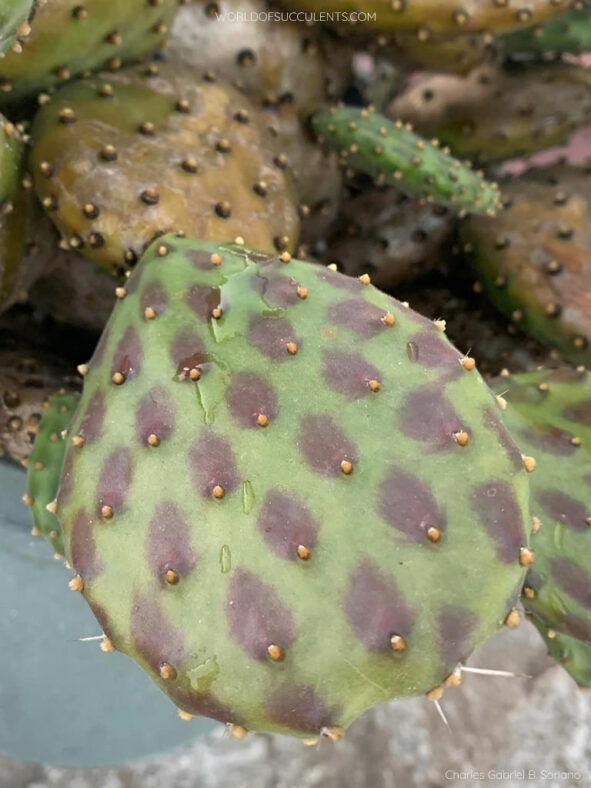Opuntia decumbens was first described by Joseph de Salm-Reifferscheidt-Dyck and published in his Hortus Dyckensis ou Catalog des Plantes in 1834.
Scientific Name
Opuntia decumbens Salm-Dyck
Common Name(s)
Decumbens Cactus
Synonym(s)
Opuntia irrorata, Opuntia repens
Scientific Classification
Family: Cactaceae
Subfamily: Opuntioideae
Tribe: Opuntieae
Genus: Opuntia
Etymology
The specific epithet "decumbens" (pronounced de-KUM-benz) means "lying down; prostrate" and refers to the growth habit of this species.
Origin
Opuntia decumbens is native to Mexico, Guatemala, Honduras, Nicaragua and Costa Rica. It occurs in tropical dry forests.
Description
Opuntia decumbens is a shrubby cactus with decumbent branches divided into flattened segments (pads) with purple or reddish pigmentation around the areoles. It can grow up to 20 inches (0.5 m) tall and often forms large colonies in its natural habitat. The pads are obovate, elliptical, or broadly ovate, reaching up to 8 inches (20 cm) in length and 4 inches (10 cm) in width. Each areole bears a tuft of yellowish-brown glochids and 1 to 3, sometimes absent, whitish or yellowish to gray spines measuring up to 0.2 inches (0.5 cm) long.
In the spring, Opuntia decumbens produces showy yellow, sometimes reddish flowers on the upper pads. The flowers can reach a length of 1.4 inches (3.5 cm) and a diameter of 1.8 inches (4.5 cm). The fruits, which are reddish-purple and spherical to pear-shaped, are edible and can grow up to 1.2 inches (3 cm) long.

How to Grow and Care for Opuntia decumbens
Light: Opuntia decumbens thrives in full sun, but some shade during midday and afternoon can prevent sunburn in hot climates. When grown indoors, a window that receives sunlight for 6 hours a day works best.
Soil: This cactus requires a well-draining soil mix. You can use a commercial cactus potting mix or create your own.
Temperature: Opuntia decumbens is highly tolerant of high temperatures and prefers cooler temperatures in winter. It grows best in USDA Plant Hardiness Zones 8a to 10b, with average minimum winter temperatures ranging from 10 to 40 °F (-12.2 to 4.4 °C).
Watering: From spring to fall, water moderately and let the soil dry out completely before watering again. In most areas, rainfall will be enough for established plants. If potted, never let the container sit in water. During the winter, suspend the watering.
Fertilizing: Opuntia decumbens does not need fertilizer when planted in the ground. However, it will benefit from fertilizing during the growing season when grown in a container. Apply a water-soluble fertilizer. Suspend feeding during the winter when the plant goes dormant.
Repotting: Repot only when the cactus becomes potbound or is too large and unstable in its container. Choose a slightly larger container with drainage holes at the bottom. The best time for repotting is late winter or early spring.
Propagation: You can propagate Opuntia decumbens by stem segments or seeds. Stem segments are the easiest method and yield faster results. For best results, take stem segments in early summer and sow the seeds in late spring.
Learn more at How to Grow and Care for Opuntia.
Toxicity of Opuntia decumbens
Opuntia decumbens is not toxic to humans or pets. However, it is best kept away from pets and children as its spines and glochids may cause skin irritation.
Links
- Back to genus Opuntia
- Succupedia: Browse succulents by Scientific Name, Common Name, Genus, Family, USDA Hardiness Zone, Origin, or cacti by Genus
Photo Gallery
Click on a photo to see a larger version.


